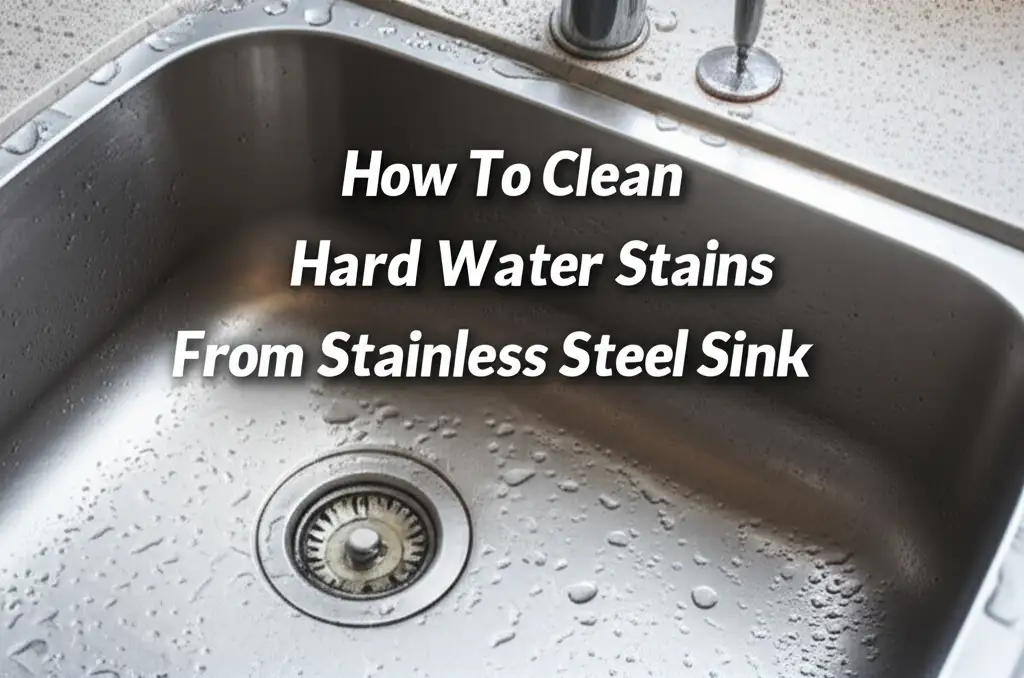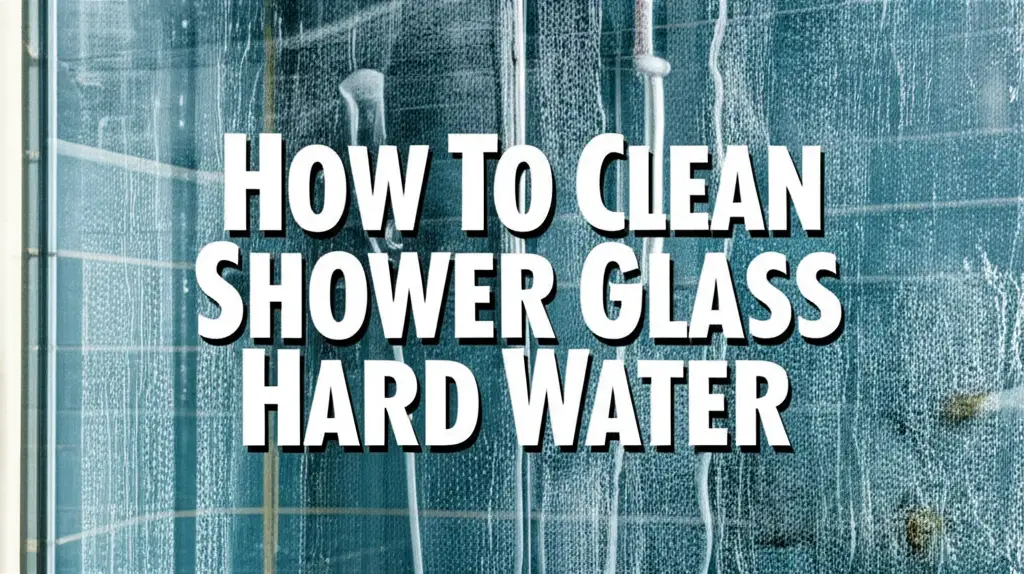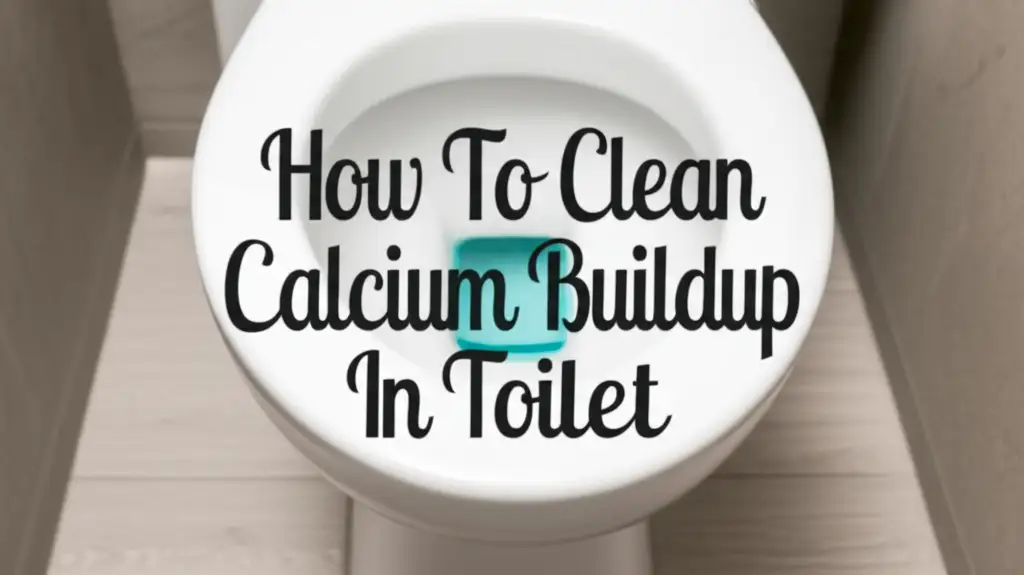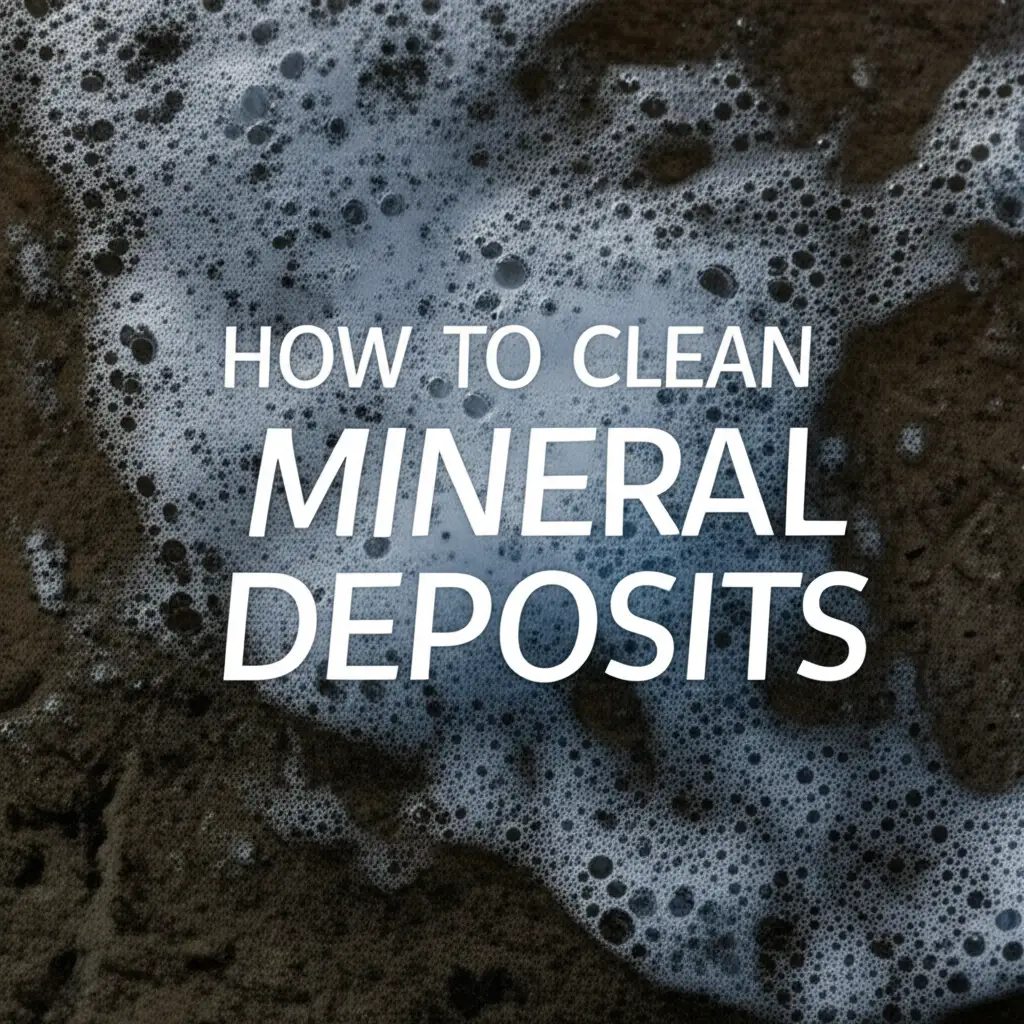· Home Cleaning · 13 min read
How To Clean Hard Water Stains From Stainless Steel Sink

Transform Your Sink: How to Clean Hard Water Stains from Stainless Steel
My stainless steel sink used to look dull. Hard water stains covered its surface. These mineral deposits made my kitchen look untidy. I know many people face this same problem. It makes me feel frustrated to see a cloudy sink.
Learning how to clean hard water stains from stainless steel sink surfaces changed my kitchen. It also saved me money. You do not need expensive products. This guide helps you restore your sink’s shine. We will explore simple, effective methods. I will show you how to make your stainless steel sparkle again.
Takeaway:
- Use white vinegar or lemon juice for mild stains.
- Apply a baking soda paste for tougher buildup.
- Consider commercial descalers for very stubborn deposits.
- Prevent future stains by wiping your sink dry after each use.
How do you clean hard water stains from a stainless steel sink? You clean hard water stains from a stainless steel sink by using acidic solutions like white vinegar or lemon juice to dissolve mineral deposits. For tougher stains, a paste of baking soda can gently abrade them away. Always rinse well and dry the sink completely to prevent new stains.
Understanding Hard Water and Its Impact on Stainless Steel
Hard water is common in many homes. It contains high levels of dissolved minerals. Calcium and magnesium are the main culprits. When this water dries, it leaves mineral deposits. These deposits appear as white, chalky stains. They stick firmly to surfaces like your stainless steel sink.
Stainless steel is durable. However, it can still show these unsightly marks. Hard water stains make your sink look dirty. They also reduce its natural shine. Over time, these mineral buildups can even trap dirt. This makes cleaning harder later. Knowing how hard water affects your sink helps you choose the right cleaning method. It also helps you protect your sink’s surface for years to come.
Identifying Hard Water Stains vs. Other Sink Marks
It is important to know what you are cleaning. Hard water stains look like white or off-white spots. They may appear cloudy or chalky. These stains are mineral deposits left behind by evaporating water. They feel rough to the touch. You might see them around faucets or drains.
Other marks can appear on your sink. Rust spots look reddish-brown. They come from metal objects left on the surface. Scratches are thin lines. They result from abrasive scrubbing or sharp objects. Grease buildup feels slimy or sticky. It often appears as a dull film. Identifying the stain helps you pick the right cleaner. Using the wrong cleaner can harm your sink. For different cleaning challenges, you might find a comprehensive cleaning guide useful.
Preparing Your Sink for Cleaning
Before you start cleaning, prepare your sink. Remove all dishes, sponges, and anything else from inside the sink. This gives you clear access to all stained areas. You want to see every spot that needs attention. Wipe down the sink with a damp cloth first. This removes any loose food particles or surface grime.
A clean, empty sink allows your chosen cleaner to work best. It prevents new dirt from mixing with the cleaning agents. This step is simple but very important. It sets the stage for effective stain removal. Always start with a clear workspace.
Gathering Your Essential Cleaning Tools and Supplies
You need specific items to clean hard water stains. Gather these tools before you begin. Having everything ready saves time. It makes the cleaning process smooth. You will need a spray bottle. This is for applying liquid cleaners evenly.
Microfiber cloths are great for wiping and polishing. They do not scratch surfaces. A soft scrub brush or sponge helps with stubborn spots. Avoid steel wool. Steel wool can scratch stainless steel. You might also need a small bowl for mixing pastes. Have a drying towel ready for the final step.
Common Household Ingredients:
- White Vinegar: This is an excellent acidic cleaner. It dissolves minerals well.
- Lemon Juice: Fresh lemon juice works like vinegar. It also leaves a pleasant scent.
- Baking Soda: A gentle abrasive that helps lift stains.
- Dish Soap: For general cleaning and removing grease.
These common items are often found in your pantry. They are safe for stainless steel. They are also gentle on your hands. For more general household cleaning tips, consider exploring other resources.
Natural Remedies: Vinegar and Lemon Power
Natural cleaners are effective for hard water stains. White vinegar is my go-to choice. Its acidity breaks down mineral deposits. Lemon juice works similarly. It leaves a fresh smell too. Both are safe for your sink and gentle on your skin. I often start with these options first.
Using White Vinegar for Hard Water Stains:
- Empty the sink: Make sure your sink is completely empty.
- Spray or apply: Pour white vinegar into a spray bottle. Spray it directly onto the stained areas. You can also soak paper towels in vinegar. Lay them over stubborn stains.
- Let it sit: Let the vinegar sit for at least 15-30 minutes. For severe stains, leave it for an hour. The longer it sits, the more it dissolves the minerals.
- Scrub gently: Use a soft scrub brush or sponge. Gently scrub the stained areas. The stains should start to loosen.
- Rinse and dry: Rinse the sink thoroughly with warm water. Make sure no vinegar residue remains. Dry the sink completely with a clean microfiber cloth. This step prevents new water spots.
Lemon Juice Method:
- Cut a lemon: Cut a fresh lemon in half.
- Rub directly: Rub the lemon half directly onto the hard water stains. Squeeze the lemon slightly to release juice.
- Let it sit: Let the lemon juice sit on the stains for 10-15 minutes.
- Scrub and rinse: Scrub gently with a soft sponge. Rinse the sink well with water.
- Dry: Dry the sink completely to reveal the shine.
Both vinegar and lemon are powerful descalers. They work well on mild to moderate hard water stains. Always ensure proper ventilation when using vinegar. The smell can be strong.
Baking Soda: The Gentle Abrasive Solution
Baking soda is another excellent natural cleaner. It is mildly abrasive. This means it can scrub away stains without scratching your sink. Baking soda is also an alkali. It helps neutralize acidic stains and odors. I find it very useful for stains that need a little more scrubbing power. It is safe and environmentally friendly.
Creating a Baking Soda Paste:
- Make a paste: Mix a few tablespoons of baking soda with a small amount of water. Add water slowly until it forms a thick paste. The paste should be like toothpaste.
- Apply to stains: Apply the baking soda paste directly onto the hard water stains. Cover all the stained areas.
- Let it sit: Let the paste sit on the stains for 15-20 minutes. This allows the baking soda to soften the mineral deposits.
- Scrub gently: Use a soft sponge or cloth. Gently scrub the paste into the stains. Use circular motions. You will see the stains lift away.
- Rinse thoroughly: Rinse the sink very well with warm water. Make sure to remove all baking soda residue.
- Dry completely: Dry the sink with a clean, dry microfiber cloth. This reveals a sparkling, clean surface.
For very stubborn stains, you can combine baking soda with vinegar. Apply the baking soda paste first. Then, spray vinegar over the paste. It will fizz. This reaction helps lift tough deposits. After the fizzing stops, scrub and rinse as usual. This combination is powerful.
Stronger Solutions: Commercial Cleaners and Specialized Products
Sometimes, natural remedies are not enough. Very stubborn hard water stains may need stronger cleaners. Commercial descalers are designed for this purpose. These products contain acids that dissolve mineral buildup. Always read product labels carefully. Follow all instructions for safe use.
Choosing a Commercial Descaler:
- Look for “calcium, lime, and rust remover”: These products target hard water minerals specifically.
- Check for “stainless steel safe”: Ensure the product will not damage your sink’s finish. Some strong acids can etch or discolor stainless steel.
- Read reviews: Other users’ experiences can guide your choice.
How to Use Commercial Cleaners:
- Wear protection: Always wear rubber gloves. Good ventilation is also important. Open windows or turn on a fan.
- Test in an inconspicuous area: Apply a small amount of cleaner to a hidden spot. This checks for any adverse reactions.
- Apply the cleaner: Follow the product instructions. Usually, you apply the cleaner directly to the stained areas.
- Allow dwell time: Let the cleaner sit for the recommended time. This time allows the chemicals to work. Do not leave it on longer than specified.
- Scrub and rinse: Use a non-abrasive sponge or cloth. Scrub gently. Rinse the sink thoroughly with clean water. Rinse multiple times to remove all chemical residue.
- Dry: Dry the sink completely with a clean cloth.
Some specialized products are made just for stainless steel. These often clean, polish, and protect the surface. They can help restore the sink’s luster after stain removal. Remember, strong chemicals require caution. Always prioritize safety. Kitchen cleaning secrets can reveal more specific product recommendations.
Polishing Your Stainless Steel Sink for a Brilliant Shine
After cleaning, polishing gives your sink a brilliant shine. It helps maintain the stainless steel’s appearance. Polishing also adds a protective layer. This layer can repel water and minor stains. My sink always looks better after a good polish.
Steps for Polishing:
- Ensure dryness: Make sure your sink is completely dry. Any water spots will show through the polish.
- Apply oil: Put a few drops of olive oil, mineral oil, or a specialized stainless steel polish onto a clean microfiber cloth. You do not need much.
- Rub with the grain: Gently rub the oil onto the sink surface. Always rub in the direction of the stainless steel grain. Stainless steel has a faint grain pattern. Rubbing with it prevents streaks. It also helps hide small scratches.
- Buff gently: Use a separate clean, dry microfiber cloth. Buff the sink surface until it shines. Remove any excess oil. The goal is a streak-free, gleaming finish.
Polishing makes a big difference. It enhances the cleaned surface. It also helps prevent future water spots from sticking. Polishing once a week can keep your sink looking new.
Preventing Future Hard Water Stains
Prevention is key to keeping your stainless steel sink clean. It is easier to prevent stains than to remove them. Simple habits can make a big difference. I practice these steps daily. They keep my sink sparkling with less effort. This means less time spent scrubbing later.
Daily Habits for Prevention:
- Wipe dry after each use: This is the most important step. After washing dishes or using the sink, wipe it dry. Use a microfiber cloth or paper towel. This removes standing water. It prevents mineral deposits from forming.
- Clean regularly: Do not let grime build up. A quick wipe-down with dish soap and water daily helps. This removes any food residue or light water spots before they become set.
- Use a water softener: If your home has very hard water, consider a water softener system. This system removes minerals from your entire water supply. It protects all your appliances and fixtures. It is a larger investment but can save a lot of cleaning effort.
- Apply a protective coating: Some stainless steel polishes create a barrier. This barrier helps repel water and oils. It can make future cleaning easier. Apply these coatings periodically as directed by the product.
By adopting these preventative measures, you greatly reduce the frequency and severity of hard water stains. My sink stays cleaner longer. This gives me more time for other things.
Maintaining Your Stainless Steel Sink for Long-Term Shine
Long-term care keeps your stainless steel sink looking its best. Regular maintenance goes beyond just cleaning stains. It involves protecting the surface. This helps avoid common problems. My sink has maintained its shine for years because of good habits.
Tips for Ongoing Maintenance:
- Avoid abrasive cleaners: Do not use steel wool, abrasive sponges, or harsh scouring powders. These can scratch the stainless steel. They also dull its finish.
- Do not leave metal objects in the sink: Wet metal objects can cause rust spots. Always remove cans, cast iron, or steel utensils promptly.
- Rinse thoroughly: Always rinse the sink completely after cleaning. Any leftover cleaning product can cause discoloration.
- Clean drain regularly: Food particles and soap scum can build up in the drain. This can lead to odors and blockages. Use a mixture of baking soda and vinegar. Pour it down the drain. Rinse with hot water.
- Address scratches quickly: Minor scratches can be polished out. Use a specialized stainless steel scratch remover kit. Follow the product instructions carefully.
Consistent care ensures your stainless steel sink remains a beautiful part of your kitchen. It saves you from needing major restoration work. A well-maintained sink adds value to your home. Keeping your entire kitchen clean can be simple with simple kitchen cleaning strategies.
FAQ Section
Q1: Can I use bleach on my stainless steel sink? No, do not use bleach on your stainless steel sink. Bleach contains chlorine. Chlorine can cause discoloration and pitting on stainless steel surfaces. It can also lead to rust. Always use cleaners safe for stainless steel. Stick to recommended products or natural alternatives.
Q2: How often should I clean hard water stains from my sink? The frequency depends on your water hardness and sink usage. For hard water, wipe your sink dry daily to prevent stains. For deeper cleaning, address visible stains weekly or as needed. Regular maintenance keeps buildup minimal. This makes cleaning easier each time.
Q3: Will olive oil really polish my sink? Yes, olive oil can polish your stainless steel sink. It helps create a streak-free shine. It also repels water and fingerprints. Apply a small amount on a microfiber cloth. Rub it with the grain of the steel. Then buff it clean. It is a simple, natural way to add luster.
Q4: What causes rainbow-like stains on stainless steel? Rainbow-like stains are often caused by heat tint. This happens when the stainless steel gets very hot. It can also be from certain chemicals. These stains are usually harmless. They can often be removed with a mild abrasive cleaner like baking soda paste.
Q5: Are there specific cloths best for stainless steel? Yes, microfiber cloths are best for stainless steel. They are soft and absorbent. They do not scratch the surface. They also leave a streak-free finish. Avoid abrasive sponges or steel wool pads. These can damage your sink’s protective layer.
Q6: Can I use a regular descaler for my coffee machine on my sink? Check the product label carefully. Some coffee machine descalers are safe for stainless steel. Others may contain ingredients too harsh for sinks. Always ensure the product states it is safe for stainless steel surfaces. If unsure, use a dedicated sink cleaner or natural methods.
Conclusion
Cleaning hard water stains from your stainless steel sink is straightforward. You now have effective strategies. We explored using natural cleaners like vinegar and baking soda. We also discussed stronger commercial options. Regular polishing brings back the shine. Most importantly, daily habits prevent future stains. Wiping your sink dry after each use is a simple, powerful step.
I hope these methods help you achieve a sparkling, clean sink. A clean sink makes your whole kitchen feel better. Do not let hard water stains dull your home. Take action today. Start with the easiest methods. See the amazing transformation. A clean, shiny stainless steel sink is within your reach. Get ready to enjoy your renewed kitchen space.
- hard water stains
- stainless steel sink cleaning
- limescale removal
- DIY cleaning
- kitchen cleaning




